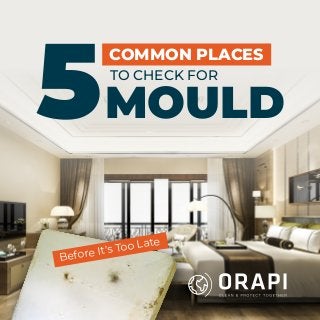
5 Common Places to Check for Mould
- 1. TO CHECK FOR COMMON PLACES 5MOULD Before It’s Too Late
- 2. WINDOW FRAMES & SILL Moisture is the number one culprit for causing moulds. Unfortunately, in a tropical climate like that of Southeast Asia, there’s no way of controlling it because a high level of humidity indicates a high level of moisture in the air, an ideal condition for mould growth. So, to keep mould at bay, we must keep an eye out for their growth in these areas.
- 3. CARPETING, UPHOLSTERY, AND FABRIC Fabric surfaces are porous and are known for collecting mould. Anything from spilt drinks to contact with sweat or condensation can cause moisture to get trapped in the fabric. Carpets, clothing, couches, and towers are among the many surfaces prone to mould growth. Mildew can grow on any of these things if you leave them wet for too long, and once mildew spreads, mould is sure to follow.
- 4. RECOMMENDATION CARPETKLEEN Vacuuming by itself is not enough to eliminate mould and mildew. You would need a chemical cleaner such as CARPETKLEEN that cleans all-natural and synthetic fibres as well as dries quickly to a non-sticky and residue-free finish. Plus, it delays the return of dirt, restores matted fibres to their natural look, and leaves a fresh lavender fragrance behind.
- 5. CURTAINS AND COUCHES As mentioned before, fabric and upholstery do a great job of collecting mould spores. Moreover, mould often grows in damp and dark conditions, and since curtains and couches are mostly used and kept indoors, they are more susceptible to mould growth. Mould build-up around couches especially can have real health concerns, at worst and at best, make the house dirty.
- 6. MATTRESS A mix of humidity and bacteria can cause mould to grow on mattresses. Especially mattresses in direct contact with the floor have a slightly higher chance of mould growth since the underside is usually left unventilated, which enables the build-up of heat and moisture, creating the perfect scenario for mould to thrive in.
- 7. RECOMMENDATION MILDEX Don’t know how to get rid of those black spots caused by moulds? MILDEX is the solution you need. It is a heavy-duty chlorinated formula that penetrates and breaks down the mildew stains at the root without any scrubbing.
- 8. WOODEN TABLES Mould can also develop on painted legs of tables due to elevated humidity. In this case, the mould growth is possibly feeding off the settled dust accumulated on the painted surface. Mould growth like this only occurs in rooms with very high humidity levels. Again, we recommend using MILDEX, which is also effective on wood surfaces.
- 9. DO YOU FIND THIS HELPFUL? AND DO YOU WANT TO LEARN MORE? Click on the link in the description to visit our website, read our articles and learn more about how you can enhance your quality of living.
- 10. orapiasia.com
